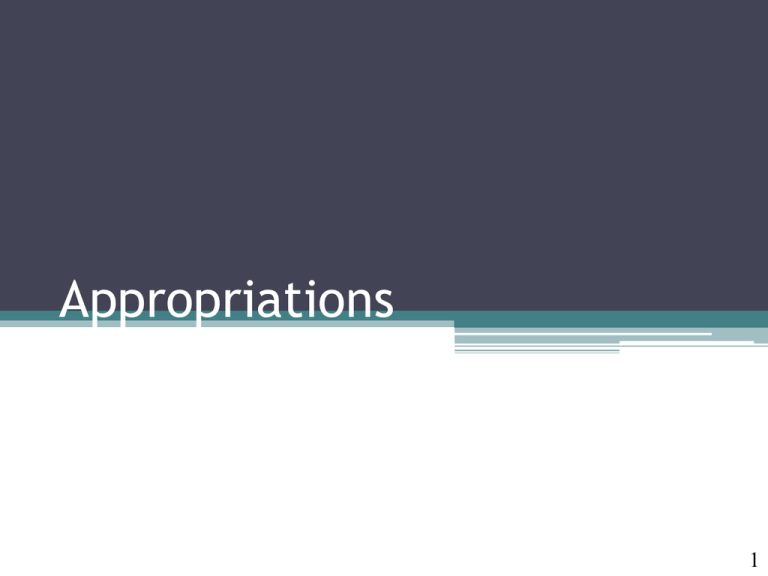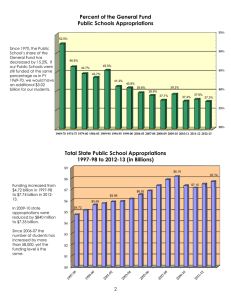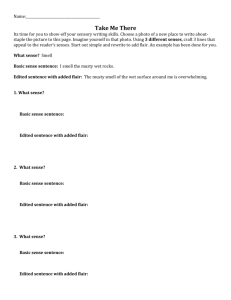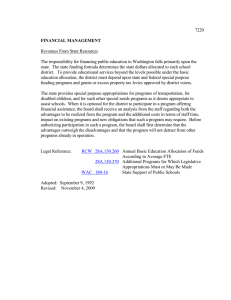Appropriations 1
advertisement

Appropriations 1 Types of Budget • State Agencies use three budget types: ▫ Operating ▫ Fixed Capital Outlay ▫ Non-Operating • Operating and Fixed Capital Outlay budgets are requested and funded in an appropriation year through the same process. • However, at the end of the fiscal year they are treated differently for retaining unexpended funds (see section on Carry Forward Process). 2 The Budget Development Cycle (Operating Appropriations) • July 15 -- Budget instructions for upcoming fiscal year due to agencies [216.023(3), F.S.] • September 30 -- Agencies submit their LongRange Program Plan (LRPP) - 5 year plan (updated annually) [186.021 and 216.013, F.S.] • October 15 -- State agencies and the judicial branch submit the Legislative Budget Request [216.023(1) and (2), F.S.] 3 The Budget Development Cycle (Operating Appropriations) • January/February -- At least 30 days prior to the scheduled annual regular session, the Governor shall furnish each senator and representative a copy of his or her recommended budget and revenues [216.162, F.S.] • January/February -- Not later than 14 days after the Governor submits his recommended budget to the Legislature, the Executive Office of the Governor shall submit to the legislative committees: ▫ a recommended appropriations bill ▫ economic impact statements ▫ appropriate staff analyses and supporting materials ▫ all legislation in bill form which will be necessary to fully implement the Governor's recommendations [216.164 and 216.166, F.S.] 4 The Budget Development Cycle (Operating Appropriations) • May -- Regular legislative session ends sixty days after beginning [early March] date. • May/June -- General Appropriations Act (Conference Committee Report) is sent to Governor. • May/June -- Governor reviews General Appropriations Act and submits veto message within 7 or 15 days (depending upon whether the act was received while the Legislature was in session). • July -- EOG posts the Original Approved Budget and transmits to the Chief Financial Officer (CFO) [216.181, F.S.] and notifies the CFO and agencies of the Annual Release Plan [216.192(1), F.S.]. 5 General Appropriations Act, Page 296 Line No. Service/BE Source of Appropriation and Amount Category Description 6 The Budget Execution Cycle (Operating Appropriations) • Agencies must ensure new account codes are set up prior to the posting of the budget. • GAA Elements (Program, Service/Budget Entity, Appropriation categories, Fund) are passed to the CFO for posting. • The CFO posts all budgetary amounts into state accounts through a batch file load process. • Agencies who want tighter controls assist in allocating the budget to a lower more detailed fund identifier and/or internal budget indicator combination. 7 Legislative Appropriations System/Planning & Budgeting Subsystem (LAS/PBS) and FLAIR • For most LAS/PBS Appropriation Codes there is at least one FLAIR Account Code. There are currently 38,597 active FLAIR Account Codes. • On a monthly basis LAS/PBS and FLAIR exchange Information: • From LAS/PBS : • Appropriations • Releases • Amendments • To LAS/PBS • Receipts • Disbursements 8 LAS/PBS and FLAIR • LAS/PBS Program Component • EOG maintains in LAS/PBS a 10 digit code used to group related activities or objectives which can be logically considered an entity for planning and budgeting purposes. • FLAIR State Program • In FLAIR the LAS/PBS Program Component code is the first ten digits of the 16 digit State Program Identifier (SPI). The last six digits of the State Program Identifier can be titled by State agencies but, once titled the code becomes a State Standard. A SPI is carried on every FLAIR transaction and is part of the monthly detail provided to LAS/PBS. 9 Non-Operating Budget • Non-operating budget defined in 216.181(12), F.S. as disbursement authority for: ▫ Purchase of investments ▫ Refunds ▫ Payments to the US Treasury ▫ Transfers of funds specifically required in law ▫ Distributions of assets held by the state in a trustee capacity ▫ Special expenses and other categories as deemed necessary 10 Non-Operating Budget • May/June - Agencies request non-operating budget authority for the fiscal year beginning July 1. • June/July – The EOG posts the authorized budget and release and transmits to the CFO for posting to Central FLAIR. 11 Budgetary Amounts Maintained in Central FLAIR • Appropriation - Legal authorization to make expenditures. • Reserves – Appropriation may be placed in reserve due to a deficit in availability of funds or until additional information is provided or a set of conditions is met. • Approved Budget- Budget available for expenditures by an agency (appropriations less any reserve amount). • Release – Control on the availability of budget for expenditures (i.e. released 100% at beginning of fiscal year, or released quarterly at 25% per quarter). • All of these budgetary amounts are posted at the start of the fiscal year by the CFO. 12 Current Year Releases • No later than August 1, the EOG publishes a release schedule, in accordance with section 216.192, F.S., for the Appropriations Act and other appropriations. • Prior to the release schedule, the Chief Financial Officer may release up to 25 percent of the original approved operating budget of each agency and of the judicial branch (section 216.192,F.S.). 13 Departmental vs. Central FLAIR Budget • Historically, the CFO does not require an Agency to enter appropriations, releases, amendments or allotments to Departmental FLAIR in order to operate. • In the 2009 Legislative Session, Chapter 215.985 F.S., was created listing specific reporting requirements for transparency. This included budgetary allotments from Departmental FLAIR. • Agencies are now required to post allotments in Departmental FLAIR. However, they are not required to “turn-on” budget checking. 14 Departmental vs. Central FLAIR Budget • Central FLAIR maintains the official cash and budget for the State. • The available budget and cash checking within Central FLAIR will prevent an agency from expending public funds in excess of the current balances. • Some agencies perform reconciliations to make sure their Departmental records are aligned with Central FLAIR. 15 Budget Amendments 16 Amendments • Agencies may amend budgetary amounts maintained for operating and non-operating Appropriations, Reserve, Approved Budget, and or Release during the fiscal year to: ▫ Transfer existing appropriations (216.292, F.S.) ▫ Request new appropriations (216.181,F.S.) ▫ Move budget from Reserve ( 216.192, F.S.) ▫ Request early or additional release (216.192, F.S.) ▫ Request new or changes to Non-Operating budget (216.181, F.S.) 17 Amendments Agency Transfers • Section 216.292 (2) F.S., allows agency heads to authorize the transfer of budget to increase or decrease an operating category by 5 percent or $250,000 , whichever is greater. ▫ Transfers can be between categories within the same budget entity and fund, or ▫ Between budget entities within identical categories and fund • These transfers are posted by the EOG and transmitted for posting into Central FLAIR 3 working days after the receipt of the request. • These transfers will impact the budgetary amounts maintained for Appropriation, Approved Budget, and Release. 18 Amendments Agency Transfers • Section 216.292(2) allows agency heads to authorize the transfer of funds between certain operating categories within the same budgetary program and fund without limit. • These are posted by the EOG and transmitted to Central FLAIR within 5 working days of the receipt of the request. • These transfers will impact the budgetary amounts maintained for Appropriation, Approved Budget, and Release. 19 Amendments Agency Transfers • 216.292(3 and 4) F.S., allows agencies to request the transfer of funds between categories, budgetary programs, and trust funds (excluding General Revenue) outside of what is allowed under the agency head authority. • If the cumulative change to a fund is less than $1 million, then the request is reviewed by the EOG and put on a 14 day consultation with the House and Senate. • If more than $1 million, the request requires the approval of the Legislative Budget Commission. • After approval, the EOG posts and transmits to Central FLAIR. • These transfers will impact the budgetary amounts maintained for Appropriation, Approved Budget, and Release. 20 Amendments New Appropriations • 216.181 (11), F.S. allows for the amendment of budgets when interim action is necessary ▫ Due to a set of conditions that were unforeseen at the time the General Appropriations Act was adopted, or ▫ If additional grants or donations are received • Depending upon the amount and the cumulative prior changes to the trust fund, the request may require a 14 day consultation with House and Senate staff, or may require approval by the Legislative Budget Commission. • After approval, the EOG posts and transmits to Central FLAIR. • These amendments will impact the budgetary amounts maintained for Appropriation, Approved Budget, and Release, and may impact Reserve. 21 Amendments Reserves • Mandatory Reserve - Reductions of spending authority placed on Appropriations to resolve a projected deficit in a fund. • Budgetary Reserve - Mechanism used to withhold appropriations or a portion thereof, until certain conditions are met. Usually included in proviso language in the GAA. 22 Amendments Reserves • 216.192(1), Agencies may request to establish budget from reserve. • Usually filed when a set of conditions has been met, or additional information has been provided. • After EOG review, placed on a 14 day consultation with House and Senate. • After approval, the EOG posts and transmits to Central FLAIR. • These amendments will impact the budgetary amounts maintained for Approved Budget, Reserve, and Release. 23 Amendments Early or Additional Release • Agencies may file budget amendments to amend the release plan in 216.192. • After EOG review, the request is placed on consultation with the House and Senate for 3 working days. • After approval, EOG posts and transmits to Central FLAIR. • These amendments will impact the budgetary amounts maintained for Release. 24 Amendments Non-Operating • 216.181(12), F.S. – Agencies may submit budget amendments to add new or increase existing nonoperating categories. • Depending upon the n0n-operating category , the amendment may be approved and immediately posted by the EOG (service charge and refunds), or after review by the EOG be placed on a 14 day consultation with the House and Senate. • After approval, the EOG posts and transmits to Central FLAIR. • These amendments will impact the budgetary amounts maintained for Appropriation, Approved Budget, and Release. 25 Amendments Supplemental Appropriations • Adjustments to accounts on the July 1 Appropriation Ledger: ▫ Substantive legislation creating a new function may include an appropriation amount not in the GAA. The EOG has to add these amounts to the Appropriation Ledger when the bill becomes law. ▫ Administered Funds – included as a lump sum in the GAA and then divided among agencies, categories, funds, as applicable. • The EOG posts these amounts to the appropriation ledger and transmits to Central FLAIR. 26 Amendments Additional Appropriations • Adding new accounts that were not on the original July 1 Appropriation Ledger, such as: ▫ ▫ ▫ ▫ New grants Establishment of new agencies Establishment of new budget entities New categories for emergency response 27 Budget Process Carried Forward 28 Carried Forward • Section 216.301, F.S., requires agencies, by June 30, to identify incurred obligations which have not been disbursed. • Incurred obligations may include services/or commodities received but not yet paid (payables) - (Type A) and services/or commodities ordered but not yet received or paid (encumbrances) - (Type B). • Carried Forward amounts cannot be used for any obligation not originally identified at year end. • Amounts are limited by the cash and investment balances of a trust fund and the unexpended release balance as of June 30. 29 Carried Forward • Carried Forward allows an agency to use unspent operating appropriations to pay for identified transactions after the end of the fiscal period. • Applies to both Operating appropriations and Fixed Capital Outlay appropriations (Certified Forward). 30 Carried Forward Process • DFS automatically marks all accounts payable and encumbrance subsidiary records in FLAIR that have an operating appropriation at year-end as incurred obligations (marked with a “C”) unless otherwise notified. • The unexpended release balances are locked as of June 30, and the balances are transferred to EOG as amounts tentatively available for carried forward. 31 Carried Forward Process • To reserve carried forward appropriations, agencies record items (payables and encumbrances) through the end of July. • No new records may be marked as incurred obligations after the end of July. • Agencies then disburse carry forward funds associated with the subsidiary account (“C” records) in the current year through the end of September. 32 Carried Forward Process • Agencies contact the DFS Help Desk to request the electronic transmittal of data to the Executive Office of the Governor (EOG) to complete the CF request process by the end of July. • Prior to an agency submitting its carried forward request, it can schedule a process in Departmental FLAIR to post many of the carried forward budgetary entries. These include: ▫ Record CF appropriations and releases for encumbrances and payables ▫ Record CF approved budget and allotments for encumbrances • The identified carried forward items are posted to Central FLAIR as a separate line item. 33 Carried Forward Process • At the end of July, a file is created in Central FLAIR and transferred to LAS/PBS to report incurred obligations. • At the end of July, the EOG conducts a technical review of incurred obligations and posts reversions (difference between incurred obligations and the unexpended release balances) in the appropriations ledger accordingly. 34 Carried Forward Process • Unspent carried forward operating appropriation categories revert on September 30. • A file is created by Central FLAIR and transferred to LAS/PBS to report the September 30 reversions. 35 Certified Forward, FCO • Fixed Capital Outlay certified forward amounts are based on a summary of unexpended balances available to pay for project needs – contracts, obligations and/or commitments. • The agency can retain unexpended appropriations balances throughout the life of the project. • As long as a project has obligations, the agency can request to retain funds. • FCO unexpended balances can cross multiple fiscal years. 36 Certified Forward, FCO Process • FCO appropriations are requested for certification via Departmental FLAIR by August 1 each year. • Agencies must record project information in Departmental FLAIR as part of their certification request. • When the agency has completed entering the information, they request a file be transmitted to the EOG. • Nineteen months (07/13 – 02/15) after original appropriation, the unexpended balance of Fixed Capital Outlay items, not committed by a formal agreement / construction contract will revert. Education FCO appropriations have 31 months before reversion. 37 The Available Balance File 38 State Accounts - Central FLAIR • Available to each agency for inquiry only • On-line auxiliary file with real time balances • The Bureau of Financial Reporting can post manual transactions to adjust the cash and budget balances with proper approvals and documentation 39 Available Balance File – Departmental FLAIR • Available balance checking is established in the Expansion Option File by the Agency • The Available Balance File tracks the following Cash balances: ▫ Fund Cash ▫ Organization Cash • And the following Budget balances: ▫ Fund Release ▫ Budget Allotment Balances can be tracked to Contract, Grant, or Project levels. 40 Available Balance File Tracking vs. Control – Types of Balances • Cash Tracking As low as Org, Contract, Grant, or Project • Cash Control At a minimum – Fund • • Budget Tracking As low as Org, Contract, Grant, or Project Budget Control At a minimum – 29 Digit Account Code If an agency wants control at a lower level, they can set up via the Expansion Option (EO) file. 41


